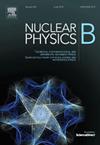f(Q)引力的热力学视界:揭示宇宙动力学
IF 2.8
3区 物理与天体物理
Q2 PHYSICS, PARTICLES & FIELDS
引用次数: 0
摘要
本文研究了f(Q)理论中允许热力学分析的宇宙动力学,其中Q描述了非度规性。我们采用具有适当比例因子的重建技术来评估这种修改的框架如何影响宇宙演化。此外,我们研究了相关宇宙量的图形表示,以研究围绕弹跳跃迁的宇宙的收缩和膨胀阶段。进一步,我们在弹跳框架的背景下研究了热力学第二定律。我们的结果表明f(Q)理论中存在可行的宇宙弹跳解的零能条件的违反。状态参数方程揭示了宇宙经历宇宙加速加速度。研究发现,这一引力理论有效地为标准宇宙学情景提供了可行的替代方案,从而对引力和早期宇宙提供了有价值的理解。本文章由计算机程序翻译,如有差异,请以英文原文为准。
Thermodynamic horizons in f(Q) gravity: Revealing cosmic dynamics
In this study, we investigate the cosmic dynamics admitting thermodynamic analysis in theory, where describes the non-metricity. We employ a reconstruction technique with an appropriate scale factor to assess how this modified framework influences cosmic evolution. Moreover, we examine the graphical representation of relevant cosmological quantities to investigate the contraction and expansion phases of the universe surrounding the bounce transition. Further, we investigate the second law of thermodynamics in the context of the bouncing framework. Our results indicate the violation of null energy condition which ensure the existence of viable cosmological bounce solutions in theory. The equation of state parameter reveals that the universe experiences cosmic accelerated acceleration. It is found that this gravitational theory effectively presents viable alternatives to the standard cosmological scenarios, hence providing valuable understanding of the gravitational force and the early universe.
求助全文
通过发布文献求助,成功后即可免费获取论文全文。
去求助
来源期刊

Nuclear Physics B
物理-物理:粒子与场物理
CiteScore
5.50
自引率
7.10%
发文量
302
审稿时长
1 months
期刊介绍:
Nuclear Physics B focuses on the domain of high energy physics, quantum field theory, statistical systems, and mathematical physics, and includes four main sections: high energy physics - phenomenology, high energy physics - theory, high energy physics - experiment, and quantum field theory, statistical systems, and mathematical physics. The emphasis is on original research papers (Frontiers Articles or Full Length Articles), but Review Articles are also welcome.
 求助内容:
求助内容: 应助结果提醒方式:
应助结果提醒方式:


